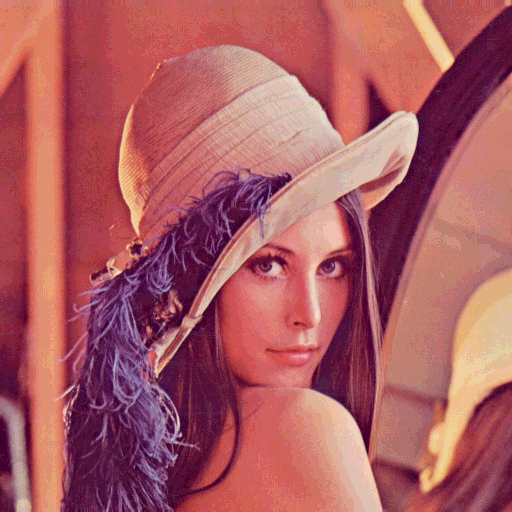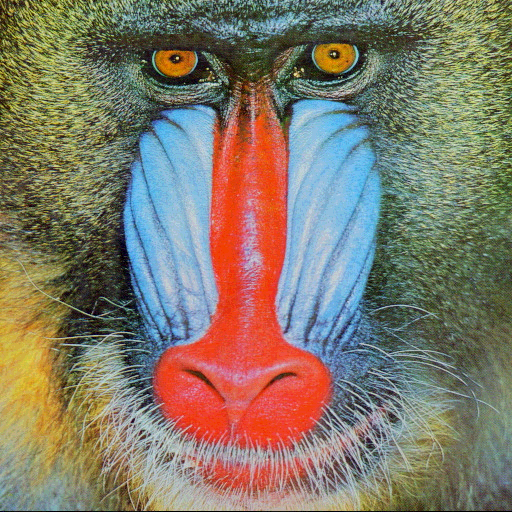This forum is disabled, please visit https://forum.opencv.org
 | 1 | initial version |
finding some time and motivated from the Instant Opencv Starter book here is an example applying steganography in spatial domain by modifying the LSB values of the pixels.
// function applies steganography in spatial domain
void steganograph(Mat &aFrontImage, Mat &aHiddenImage)
{
// check if two images are the same type and size
CV_Assert(aFrontImage.type() == aHiddenImage.type() && aFrontImage.size() == aHiddenImage.size());
// create our stego image, where we are gonna store the final result
Mat aStegedImage(aFrontImage.rows, aFrontImage.cols, aFrontImage.type());
// create some temp images that we are gonna need later for the process
Mat tFront_image, tHidden_image;
if(aFrontImage.channels() == 3) // check if we are dealing with color images
{
// populate mask matrices with the value 0xF0 or 11110000 in binary
Mat front_mask(aFrontImage.rows, aFrontImage.cols, aFrontImage.type(), Scalar(0xF0, 0xF0, 0xF0));
Mat hidden_mask(aHiddenImage.rows, aHiddenImage.cols, aHiddenImage.type(), Scalar(0xF0, 0xF0, 0xF0));
// perform bitwise ANDing of two matrices and store the result in a third matrix.
// What we achieved with this operation? Well, now the resulting tFront_image and
// tHidden_image matrices contains only the first four important bits of each pixel
// in aFrontImage. The remaining four bits are zero padded
bitwise_and(aFrontImage, front_mask, tFront_image);
bitwise_and(aHiddenImage, hidden_mask, tHidden_image);
for(int j = 0; j < aHiddenImage.rows; j++)
for(int i = 0; i < aHiddenImage.cols; i++)
{
// right-shift the pixel components of the tHidden_image matrix by 4 bits,
// and hence the first four bits are zero padded.
tHidden_image.at<Vec3b>(j,i)[0] = tHidden_image.at<Vec3b>(j,i)[0] >> 4;
tHidden_image.at<Vec3b>(j,i)[1] = tHidden_image.at<Vec3b>(j,i)[1] >> 4;
tHidden_image.at<Vec3b>(j,i)[2] = tHidden_image.at<Vec3b>(j,i)[2] >> 4;
}
}else if(aFrontImage.channels() == 1){ // check if we are dealing with grayscale images
Mat front_mask(aFrontImage.rows, aFrontImage.cols, aFrontImage.type(), Scalar(0xF0));
Mat hidden_mask(aHiddenImage.rows, aHiddenImage.cols, aHiddenImage.type(), Scalar(0xF0));
bitwise_and(aFrontImage, front_mask, tFront_image);
bitwise_and(aHiddenImage, hidden_mask, tHidden_image);
for(int j = 0; j < aHiddenImage.rows; j++)
for(int i = 0; i < aHiddenImage.cols; i++)
{
tHidden_image.at<uchar>(j,i) = tHidden_image.at<uchar>(j,i) >> 4;
}
}
// Finally, perform the bitwise addition of the tFront_image and tHidden_image matrices
// to obtain aStegedImage, which is our steganograph image
bitwise_or(tFront_image, tHidden_image, aStegedImage);
// save and show the stego image
imwrite("stegedImg.png", aStegedImage);
imshow("aStegedImg", aStegedImage);
}
// function to desteganograph an image
void deSteganograph(Mat &aStegedImage)
{
// create matrices to store the results
Mat aFrontImage(aStegedImage.rows, aStegedImage.cols, aStegedImage.type());
Mat aHiddenImage(aStegedImage.rows, aStegedImage.cols, aStegedImage.type());
// Mat tFront_image, tHidden_image;
if(aFrontImage.channels() == 3) // check if we are dealing with color images
{
// populate again the mask matrices with the values 0xF0 or 11110000 in binary
// and 0x0F or 00001111 in binary depending which image we want to retrieve
Mat front_mask(aStegedImage.rows, aStegedImage.cols, aStegedImage.type(), Scalar(0xF0, 0xF0, 0xF0));
Mat hidden_mask(aStegedImage.rows, aStegedImage.cols, aStegedImage.type(), Scalar(0x0F, 0x0F, 0x0F));
// apply again bitwise_ANDing to retrieve the images
bitwise_and(aStegedImage, front_mask, aFrontImage);
bitwise_and(aStegedImage, hidden_mask, aHiddenImage);
for(int j = 0; j < aHiddenImage.rows; j++)
for(int i = 0; i < aHiddenImage.cols; i++)
{
// left-shift the pixel components of aHidden_image by 4 bits, because
// the first four bits are zero padded and the actual information is stored
// in the last 4 bits
aHiddenImage.at<Vec3b>(j,i)[0] = aHiddenImage.at<Vec3b>(j,i)[0] << 4;
aHiddenImage.at<Vec3b>(j,i)[1] = aHiddenImage.at<Vec3b>(j,i)[1] << 4;
aHiddenImage.at<Vec3b>(j,i)[2] = aHiddenImage.at<Vec3b>(j,i)[2] << 4;
}
}else if(aFrontImage.channels() == 1){ // check if we are dealing with grayscale images
Mat front_mask(aStegedImage.rows, aStegedImage.cols, aStegedImage.type(), Scalar(0xF0));
Mat hidden_mask(aStegedImage.rows, aStegedImage.cols, aStegedImage.type(), Scalar(0x0F));
bitwise_and(aStegedImage, front_mask, aFrontImage);
bitwise_and(aStegedImage, hidden_mask, aHiddenImage);
for(int j = 0; j < aHiddenImage.rows; j++)
for(int i = 0; i < aHiddenImage.cols; i++)
{
aHiddenImage.at<uchar>(j,i) = aHiddenImage.at<uchar>(j,i) << 4;
}
}
// final images
imshow("front", aFrontImage);
imshow("hidden", aHiddenImage);
}
and the results can be seen in the following images, where if you look with carefully you can notice the distortion in modified images.
Original lena image to be the carrier:

Original baboon image to be the hidden:

Stego image:

Recovered lena image:

Recovered baboon image:

 | 2 | No.2 Revision |
finding some time and motivated from an example at the Instant Opencv Starter book here is an example applying steganography in spatial domain by modifying the LSB values of the pixels.
// function applies steganography in spatial domain
void steganograph(Mat &aFrontImage, Mat &aHiddenImage)
{
// check if two images are the same type and size
CV_Assert(aFrontImage.type() == aHiddenImage.type() && aFrontImage.size() == aHiddenImage.size());
// create our stego image, where we are gonna store the final result
Mat aStegedImage(aFrontImage.rows, aFrontImage.cols, aFrontImage.type());
// create some temp images that we are gonna need later for the process
Mat tFront_image, tHidden_image;
if(aFrontImage.channels() == 3) // check if we are dealing with color images
{
// populate mask matrices with the value 0xF0 or 11110000 in binary
Mat front_mask(aFrontImage.rows, aFrontImage.cols, aFrontImage.type(), Scalar(0xF0, 0xF0, 0xF0));
Mat hidden_mask(aHiddenImage.rows, aHiddenImage.cols, aHiddenImage.type(), Scalar(0xF0, 0xF0, 0xF0));
// perform bitwise ANDing of two matrices and store the result in a third matrix.
// What we achieved with this operation? Well, now the resulting tFront_image and
// tHidden_image matrices contains only the first four important bits of each pixel
// in aFrontImage. The remaining four bits are zero padded
bitwise_and(aFrontImage, front_mask, tFront_image);
bitwise_and(aHiddenImage, hidden_mask, tHidden_image);
for(int j = 0; j < aHiddenImage.rows; j++)
for(int i = 0; i < aHiddenImage.cols; i++)
{
// right-shift the pixel components of the tHidden_image matrix by 4 bits,
// and hence the first four bits are zero padded.
tHidden_image.at<Vec3b>(j,i)[0] = tHidden_image.at<Vec3b>(j,i)[0] >> 4;
tHidden_image.at<Vec3b>(j,i)[1] = tHidden_image.at<Vec3b>(j,i)[1] >> 4;
tHidden_image.at<Vec3b>(j,i)[2] = tHidden_image.at<Vec3b>(j,i)[2] >> 4;
}
}else if(aFrontImage.channels() == 1){ // check if we are dealing with grayscale images
Mat front_mask(aFrontImage.rows, aFrontImage.cols, aFrontImage.type(), Scalar(0xF0));
Mat hidden_mask(aHiddenImage.rows, aHiddenImage.cols, aHiddenImage.type(), Scalar(0xF0));
bitwise_and(aFrontImage, front_mask, tFront_image);
bitwise_and(aHiddenImage, hidden_mask, tHidden_image);
for(int j = 0; j < aHiddenImage.rows; j++)
for(int i = 0; i < aHiddenImage.cols; i++)
{
tHidden_image.at<uchar>(j,i) = tHidden_image.at<uchar>(j,i) >> 4;
}
}
// Finally, perform the bitwise addition of the tFront_image and tHidden_image matrices
// to obtain aStegedImage, which is our steganograph image
bitwise_or(tFront_image, tHidden_image, aStegedImage);
// save and show the stego image
imwrite("stegedImg.png", aStegedImage);
imshow("aStegedImg", aStegedImage);
}
// function to desteganograph an image
void deSteganograph(Mat &aStegedImage)
{
// create matrices to store the results
Mat aFrontImage(aStegedImage.rows, aStegedImage.cols, aStegedImage.type());
Mat aHiddenImage(aStegedImage.rows, aStegedImage.cols, aStegedImage.type());
// Mat tFront_image, tHidden_image;
if(aFrontImage.channels() == 3) // check if we are dealing with color images
{
// populate again the mask matrices with the values 0xF0 or 11110000 in binary
// and 0x0F or 00001111 in binary depending which image we want to retrieve
Mat front_mask(aStegedImage.rows, aStegedImage.cols, aStegedImage.type(), Scalar(0xF0, 0xF0, 0xF0));
Mat hidden_mask(aStegedImage.rows, aStegedImage.cols, aStegedImage.type(), Scalar(0x0F, 0x0F, 0x0F));
// apply again bitwise_ANDing to retrieve the images
bitwise_and(aStegedImage, front_mask, aFrontImage);
bitwise_and(aStegedImage, hidden_mask, aHiddenImage);
for(int j = 0; j < aHiddenImage.rows; j++)
for(int i = 0; i < aHiddenImage.cols; i++)
{
// left-shift the pixel components of aHidden_image by 4 bits, because
// the first four bits are zero padded and the actual information is stored
// in the last 4 bits
aHiddenImage.at<Vec3b>(j,i)[0] = aHiddenImage.at<Vec3b>(j,i)[0] << 4;
aHiddenImage.at<Vec3b>(j,i)[1] = aHiddenImage.at<Vec3b>(j,i)[1] << 4;
aHiddenImage.at<Vec3b>(j,i)[2] = aHiddenImage.at<Vec3b>(j,i)[2] << 4;
}
}else if(aFrontImage.channels() == 1){ // check if we are dealing with grayscale images
Mat front_mask(aStegedImage.rows, aStegedImage.cols, aStegedImage.type(), Scalar(0xF0));
Mat hidden_mask(aStegedImage.rows, aStegedImage.cols, aStegedImage.type(), Scalar(0x0F));
bitwise_and(aStegedImage, front_mask, aFrontImage);
bitwise_and(aStegedImage, hidden_mask, aHiddenImage);
for(int j = 0; j < aHiddenImage.rows; j++)
for(int i = 0; i < aHiddenImage.cols; i++)
{
aHiddenImage.at<uchar>(j,i) = aHiddenImage.at<uchar>(j,i) << 4;
}
}
// final images
imshow("front", aFrontImage);
imshow("hidden", aHiddenImage);
}
and the results can be seen in the following images, where if you look with carefully you can notice the distortion in modified images.
Original lena image to be the carrier:

Original baboon image to be the hidden:

Stego image:

Recovered lena image:

Recovered baboon image:
